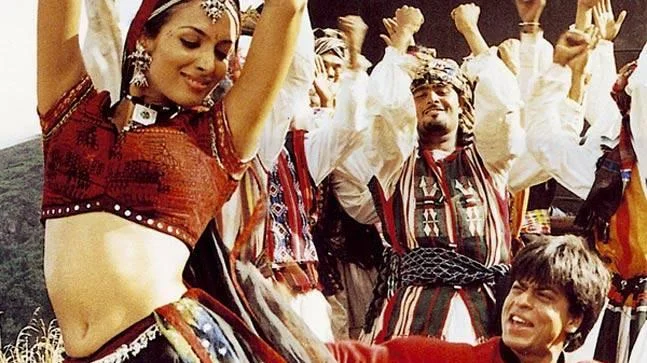Mani Ratnam's DIL SE
Movie review by Dennis D. McDonald
First I popped in the DVD and selected the “play all songs” options. Wow. I have never seen a song-and-dance production number like the one that takes place on the top of the moving train (“Chaiyya Chaiyya”). My daughter wondered, “How many people died making this?” The rest of the musical numbers are quite interesting, a mix of romance and action, including one sequence with plentiful fire and explosions.
As with other Bollywood films, the synchronization of actors’ lip movement with the actual singers’ words is uneven, but once you get past that, the music is quite exhilarating. The physical and natural surroundings are diverse ranging from lush vegetation to desert to mountaintop. Quite enjoyable. I like the dancing, too, quite different from the dancing you see in MTV music videos. I bought the soundtrack on this one.
Shah Rukh Khan (Asoka) is Amar, a radio reporter assigned to interview rebel leaders in Northern India. During his trip he becomes infatuated with a mysterious girl (Meghna) played by Manisha Koirala, who is More Than She Seems. Amar follows her from one scenic location to another and at one point he is beaten up by her “brothers” and told to get lost. Of course he continues to pine away, and just before the intermission, we learn that his mysterious “lover” is secretly a terrorist-in-training, in league with the rebels.
Following the intermission, Amar returns to his family who have arranged for his marriage to sweet young Preity Zinta. He agrees to the marriage but can’t get Meghna out of his mind — and she shows up at his relative-infested family home asking for a job and a place to stay. He arranges for her to work at the radio station, and this creates all kinds of complications, concluding with a tense and stressful police investigation that gradually unfolds the assassination plot that suicide bomber Meghna is a key player in. The movie ends with a real bang - literally.
I am still learning about Indian films. I’ve read that this one has real “Western” production values. I’m not sure exactly what that’s supposed to mean. Much of this film is gorgeously photographed, both in the exterior and the interior shots. The film spans vast geographic variety and distances, from mountain to city. Some of the interior shots are expressive and impressive. In one scene, Amar and Meghna are carrying on a tense, hushed conversation in the hallway of the radio station. A door just beyond them, which has a small window at eye level, is repeatedly opened and closed. The scene’s lighting repeatedly shifts from blue shadow to full natural color as the door is opened and closed. It’s a fascinating effect that reminded me of the flapping shadows in some movie scenes created by rotating ceiling fans — very atmospheric. I assume that cinematographer Santosh Sivan (The Terrorist) is responsible for this effect.
Overall, the heavy melodrama of this long (nearly four hours) movie may turn some people off. Amar’s infatuation with Meghna seems far-fetched. But taken as a whole, I found this whole movie fascinating. The fact that it deals with love/infatuation against a backdrop of rebellion, terrorism, and assassination makes it all the more compelling. And while the backdrop of Indian politics and border disputes is a world away from me, the reality of today’s world is that we have all learned that terrorists can strike anywhere.
Postscript
The quality of the DVD for ths movie is atrocious. Many sequences have many visible scratches, the subtitling is often out of synch with the spoken words, and the forced commercials at the beginning are difficult to bypass. Still, the color and photography shine through, and while there are no additional documentaries (I would love to see a discussion of the filming of the Chaiyya Chaiyya production number) there is a plentiful listing of other DVD’s and movies.
Review copyright (c) 2004 by Dennis D. McDonald
Update
on 2006-04-06 15:56 by Dennis D. McDonald
"Chaia Chaia" is used in the opening and closing credits of Spike Lee's Inside Man
.

